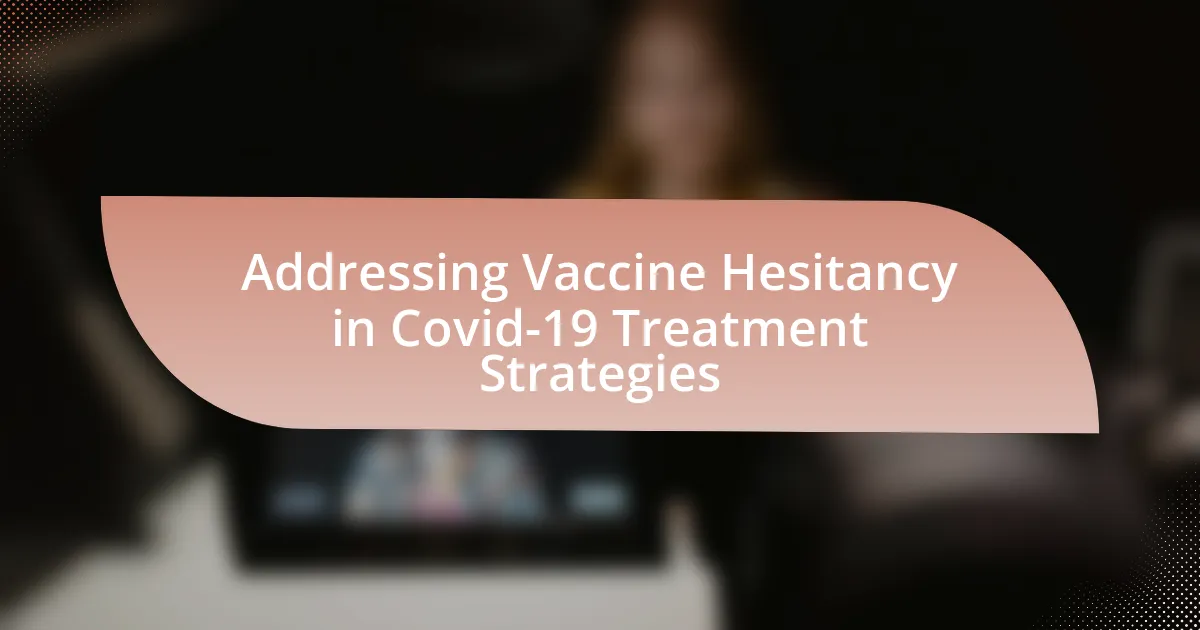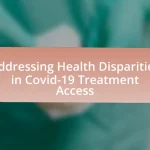Vaccine hesitancy in the context of Covid-19 refers to the reluctance or refusal to vaccinate despite the availability of vaccines, influenced by misinformation, distrust in healthcare systems, and safety concerns. This issue significantly undermines public health efforts to achieve herd immunity, prolonging the pandemic and increasing the risk of virus mutations. The article explores the factors contributing to vaccine hesitancy, the impact of misinformation, and the consequences for public health, while also discussing effective strategies for addressing these challenges through education, community engagement, and transparent communication. It emphasizes the importance of tailored messaging and the role of healthcare providers in fostering trust and improving vaccine acceptance among hesitant populations.
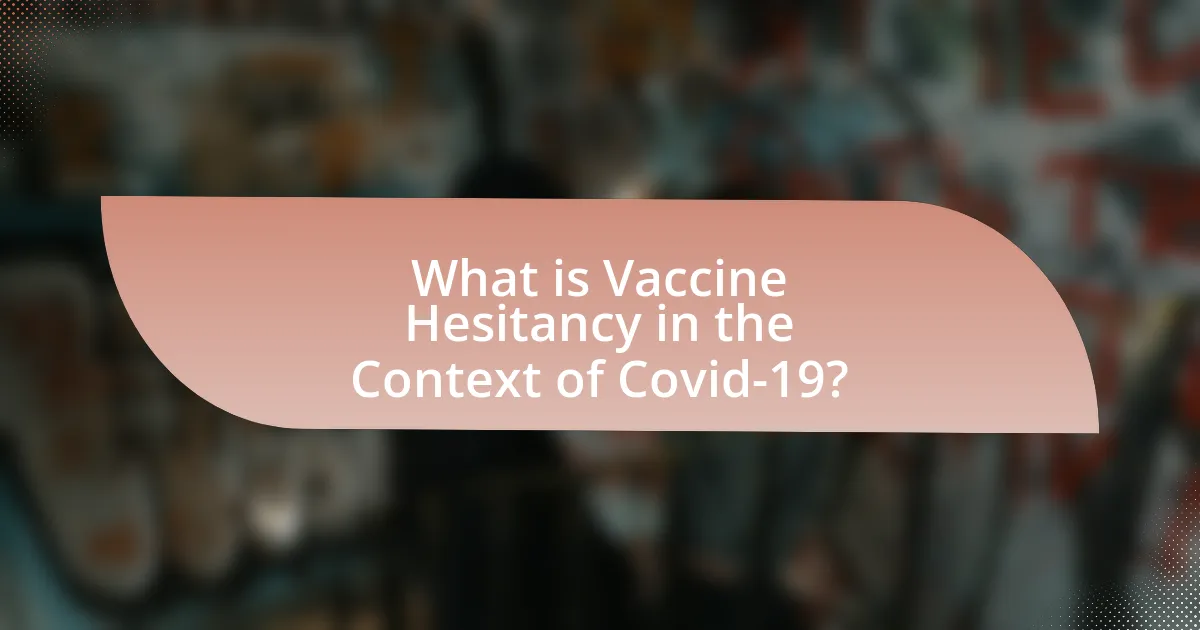
What is Vaccine Hesitancy in the Context of Covid-19?
Vaccine hesitancy in the context of Covid-19 refers to the reluctance or refusal to vaccinate despite the availability of vaccines. This phenomenon has been influenced by factors such as misinformation, distrust in healthcare systems, and concerns about vaccine safety and efficacy. According to a study published in the journal “Vaccine,” approximately 23% of adults in the United States expressed hesitancy towards Covid-19 vaccines, highlighting the significant impact of these factors on public health efforts to achieve widespread vaccination.
Why is vaccine hesitancy a significant issue during the Covid-19 pandemic?
Vaccine hesitancy is a significant issue during the Covid-19 pandemic because it undermines efforts to achieve herd immunity and control the virus’s spread. The World Health Organization reported that vaccine hesitancy can lead to lower vaccination rates, which in turn prolongs the pandemic and increases the risk of virus mutations. For instance, studies indicate that areas with high levels of vaccine hesitancy experience higher transmission rates and more severe outbreaks, as seen in various regions during the pandemic. This hesitancy is often fueled by misinformation, distrust in healthcare systems, and concerns about vaccine safety, which further complicates public health responses.
What factors contribute to vaccine hesitancy among different populations?
Vaccine hesitancy among different populations is primarily influenced by factors such as misinformation, distrust in healthcare systems, cultural beliefs, and perceived risks associated with vaccines. Misinformation, particularly spread through social media, has been shown to significantly impact public perception, leading to skepticism about vaccine safety and efficacy. Distrust in healthcare systems often stems from historical injustices and unequal treatment of marginalized communities, which can create reluctance to accept vaccines. Cultural beliefs and values also play a crucial role, as some populations may prioritize traditional medicine or have specific religious objections to vaccination. Additionally, individuals may perceive a higher risk of adverse effects from vaccines compared to the risks posed by the diseases they prevent, further contributing to hesitancy. Studies, such as those published in the journal “Vaccine,” highlight these factors as critical in understanding and addressing vaccine hesitancy across diverse groups.
How does misinformation impact vaccine acceptance?
Misinformation significantly reduces vaccine acceptance by fostering distrust and confusion among the public. Studies indicate that exposure to false information about vaccines can lead to increased hesitancy, with a survey revealing that 36% of respondents who encountered misinformation were less likely to vaccinate. This decline in acceptance is often linked to the spread of myths regarding vaccine safety and efficacy, which can overshadow factual information provided by health authorities. For instance, a systematic review published in the journal “Vaccine” found that misinformation correlates with lower vaccination rates, emphasizing the need for effective communication strategies to counteract false narratives.
What are the consequences of vaccine hesitancy for public health?
Vaccine hesitancy leads to increased rates of infectious disease outbreaks, undermining public health efforts. When a significant portion of the population refuses vaccines, herd immunity is compromised, allowing diseases like measles and COVID-19 to spread more easily. For instance, the World Health Organization reported that in 2019, measles cases surged globally, with vaccine hesitancy contributing to a 553% increase in cases compared to the previous year. This not only strains healthcare systems but also results in higher morbidity and mortality rates, particularly among vulnerable populations.
How does vaccine hesitancy affect herd immunity?
Vaccine hesitancy significantly undermines herd immunity by reducing the overall vaccination rates within a population. Herd immunity occurs when a sufficient proportion of individuals are vaccinated, thereby providing indirect protection to those who are unvaccinated. For instance, studies indicate that a vaccination coverage of approximately 95% is necessary to achieve herd immunity for diseases like measles. When vaccine hesitancy leads to lower vaccination rates, the threshold for herd immunity is not met, resulting in increased susceptibility to outbreaks and the potential resurgence of preventable diseases.
What are the implications for Covid-19 treatment strategies?
The implications for Covid-19 treatment strategies include the need for a multifaceted approach that integrates vaccination, antiviral therapies, and public health measures. This approach is essential because vaccination significantly reduces the severity of illness and transmission rates, as evidenced by studies showing that fully vaccinated individuals have a lower risk of hospitalization and death compared to unvaccinated individuals. Additionally, the incorporation of antiviral treatments, such as Paxlovid, has been shown to decrease the risk of severe outcomes in high-risk populations. Therefore, effective treatment strategies must prioritize vaccination to enhance overall public health outcomes while also providing accessible treatment options for those infected.
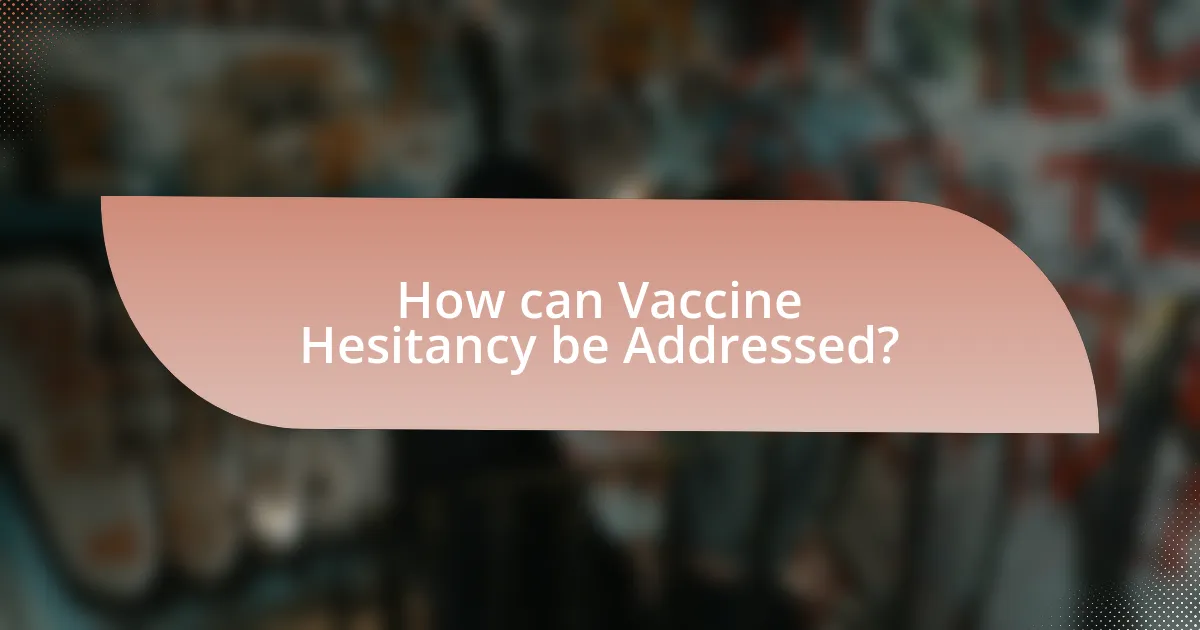
How can Vaccine Hesitancy be Addressed?
Vaccine hesitancy can be addressed through targeted communication strategies that build trust and provide accurate information. Research indicates that personalized messaging, which addresses specific concerns and misconceptions about vaccines, significantly improves acceptance rates. For instance, a study published in the journal “Vaccine” by Roozenbeek et al. (2020) found that interventions focusing on empathy and understanding individual fears led to a 20% increase in vaccine uptake among hesitant populations. Additionally, engaging community leaders and healthcare professionals to disseminate factual information can further enhance credibility and reduce hesitancy.
What strategies are effective in combating vaccine hesitancy?
Effective strategies in combating vaccine hesitancy include building trust through transparent communication, engaging community leaders, and providing accessible information. Research indicates that transparent communication about vaccine safety and efficacy can significantly reduce doubts; for instance, a study published in the journal “Vaccine” found that clear messaging from trusted sources increased vaccination rates by 20%. Engaging community leaders, such as local healthcare providers and influencers, fosters trust and encourages individuals to seek vaccination. Additionally, providing accessible information through various platforms, including social media and community outreach, ensures that accurate data reaches diverse populations, addressing specific concerns and misconceptions.
How can healthcare providers improve communication about vaccines?
Healthcare providers can improve communication about vaccines by utilizing clear, evidence-based messaging tailored to the concerns of patients. This approach involves actively listening to patients’ questions and fears, providing accurate information about vaccine safety and efficacy, and addressing misinformation directly. Research indicates that personalized communication, such as one-on-one discussions, significantly increases vaccine acceptance rates. For instance, a study published in the journal “Vaccine” found that healthcare providers who engaged in empathetic dialogue and offered tailored information were more effective in reducing vaccine hesitancy among patients.
What role do community engagement and outreach play in addressing hesitancy?
Community engagement and outreach are critical in addressing vaccine hesitancy by fostering trust and providing accurate information. Engaging with communities allows health officials to understand specific concerns and misconceptions, which can then be addressed through tailored communication strategies. For instance, studies have shown that community-led initiatives, such as local informational sessions and partnerships with trusted community leaders, significantly increase vaccine acceptance rates. A report by the Kaiser Family Foundation found that outreach efforts that included direct community involvement led to a 20% increase in vaccination rates among hesitant populations. This demonstrates that effective community engagement not only informs but also empowers individuals to make informed health decisions.
What are the best practices for public health campaigns?
The best practices for public health campaigns include clear messaging, audience segmentation, and community engagement. Clear messaging ensures that the information is easily understood and addresses specific concerns, which is crucial in combating vaccine hesitancy. Audience segmentation allows campaigns to tailor messages to different demographic groups, enhancing relevance and effectiveness. Community engagement fosters trust and encourages participation, as seen in successful campaigns like the CDC’s “Vaccinate with Confidence,” which involved local leaders to promote vaccination. These strategies have been shown to increase vaccination rates and improve public health outcomes, particularly during the COVID-19 pandemic.
How can social media be leveraged to promote vaccine acceptance?
Social media can be leveraged to promote vaccine acceptance by disseminating accurate information, engaging with communities, and countering misinformation. Platforms like Facebook and Twitter allow health organizations to share evidence-based content, such as statistics showing vaccine efficacy and safety, which can help alleviate fears. For instance, a study published in the journal “Vaccine” found that targeted social media campaigns increased vaccination rates by 20% in specific demographics. Additionally, influencers and community leaders can use their platforms to share personal stories about vaccination, fostering trust and relatability. Engaging users through interactive content, such as Q&A sessions and live discussions, can further enhance understanding and acceptance of vaccines.
What messages resonate most with hesitant populations?
Messages that resonate most with hesitant populations include those emphasizing safety, community protection, and personal health benefits. Research indicates that clear communication about vaccine efficacy and safety, coupled with testimonials from trusted community leaders, significantly influences acceptance. For instance, a study published in the journal “Vaccine” found that individuals are more likely to accept vaccination when they perceive it as a means to protect not only themselves but also their loved ones and community members. Additionally, addressing specific concerns and providing transparent information about side effects can further alleviate fears and build trust in the vaccination process.
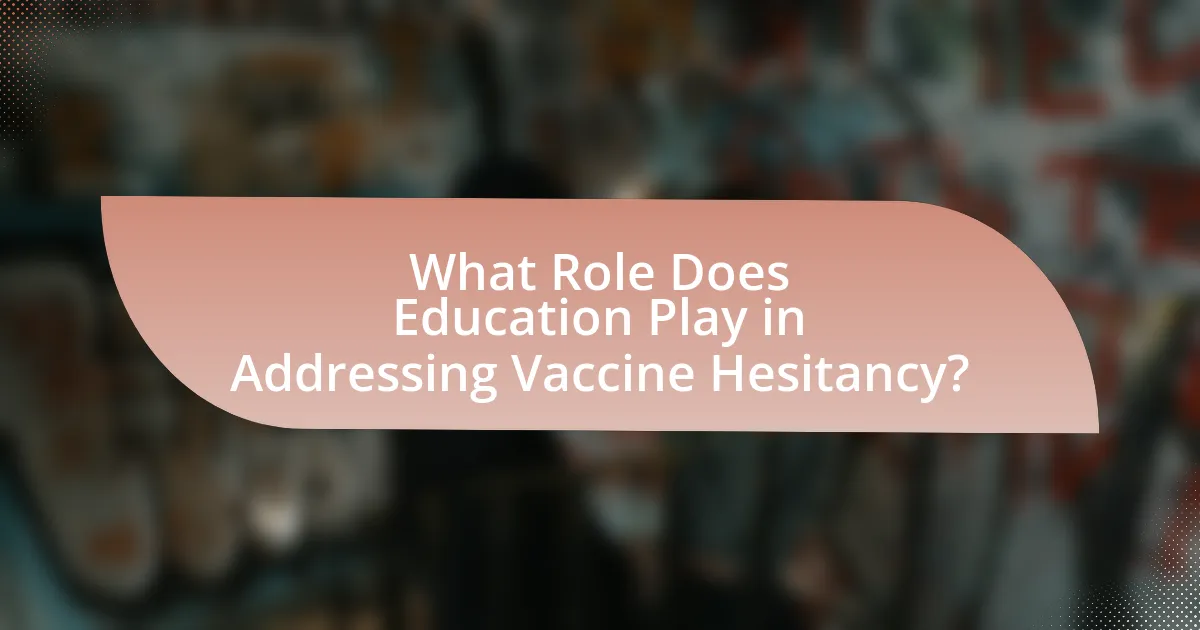
What Role Does Education Play in Addressing Vaccine Hesitancy?
Education plays a crucial role in addressing vaccine hesitancy by providing individuals with accurate information about vaccines, their benefits, and potential risks. Research indicates that informed individuals are more likely to accept vaccinations; for instance, a study published in the journal “Vaccine” found that educational interventions significantly increased vaccine acceptance rates among hesitant populations. By enhancing understanding and dispelling myths surrounding vaccines, education fosters trust in healthcare systems and encourages informed decision-making, ultimately leading to higher vaccination rates and improved public health outcomes.
How can educational initiatives reduce vaccine hesitancy?
Educational initiatives can reduce vaccine hesitancy by providing accurate information about vaccine safety and efficacy, thereby addressing misconceptions and fears. Research indicates that targeted educational programs, such as community workshops and informational campaigns, significantly increase knowledge and trust in vaccines. For instance, a study published in the journal “Vaccine” found that educational interventions led to a 20% increase in vaccination rates among hesitant populations. By fostering open dialogue and engaging trusted community leaders, these initiatives can effectively counter misinformation and encourage informed decision-making regarding vaccinations.
What types of educational materials are most effective?
Visual aids, interactive content, and personalized communication are the most effective types of educational materials for addressing vaccine hesitancy. Research indicates that visual aids, such as infographics and videos, enhance understanding and retention of information, making complex data more accessible. Interactive content, including quizzes and simulations, engages users actively, fostering a deeper connection to the material. Personalized communication, tailored to individual concerns and cultural contexts, has been shown to significantly increase trust and acceptance of vaccine information, as evidenced by studies demonstrating higher vaccination rates when educational materials are customized to the audience’s specific needs and beliefs.
How can schools and universities contribute to vaccine education?
Schools and universities can contribute to vaccine education by implementing comprehensive curricula that include accurate information about vaccines, their benefits, and the science behind them. Educational institutions can host workshops, seminars, and guest lectures featuring healthcare professionals to provide firsthand knowledge and address misconceptions. Research indicates that educational interventions can significantly improve vaccine acceptance; for instance, a study published in the journal “Vaccine” found that targeted educational programs increased vaccination rates among students by 20%. Additionally, schools and universities can leverage social media platforms to disseminate factual information and counter misinformation, further enhancing community awareness and understanding of vaccines.
What are the challenges in implementing educational strategies?
The challenges in implementing educational strategies include resistance from target audiences, lack of resources, and insufficient training for educators. Resistance often stems from pre-existing beliefs and misinformation, which can hinder the acceptance of new information. A lack of resources, such as funding and materials, limits the ability to effectively disseminate educational content. Additionally, educators may not receive adequate training to deliver these strategies effectively, resulting in inconsistent messaging and reduced impact. These factors collectively impede the successful implementation of educational strategies aimed at addressing vaccine hesitancy in Covid-19 treatment.
How can misinformation be countered in educational settings?
Misinformation can be countered in educational settings by implementing comprehensive media literacy programs that teach critical thinking and evaluation of sources. Research indicates that students who receive training in media literacy are better equipped to identify false information and understand the importance of credible sources. For instance, a study published in the Journal of Media Literacy Education found that media literacy education significantly improved students’ ability to discern misinformation related to health topics, including vaccines. By fostering an environment that encourages questioning and analysis, educational institutions can effectively reduce the impact of misinformation on vaccine hesitancy and other public health issues.
What partnerships can enhance educational outreach efforts?
Collaborations with healthcare organizations, educational institutions, and community-based organizations can significantly enhance educational outreach efforts. These partnerships leverage the expertise and resources of each entity to effectively disseminate accurate information about vaccines. For instance, a study published in the Journal of Public Health found that partnerships between local health departments and schools increased vaccination rates by 20% through targeted educational campaigns. Additionally, collaboration with community leaders can help tailor messages to specific demographics, addressing cultural concerns and misinformation directly.
What Practical Steps Can Individuals Take to Address Vaccine Hesitancy?
Individuals can address vaccine hesitancy by engaging in open conversations with trusted healthcare professionals. These discussions can provide accurate information about vaccine safety and efficacy, countering misinformation. Research indicates that personal interactions with healthcare providers significantly increase vaccination rates; for instance, a study published in the American Journal of Public Health found that patients who discussed vaccines with their doctors were more likely to get vaccinated. Additionally, individuals can share their own positive vaccination experiences on social media to influence peers, as social proof is a powerful motivator in health behavior.
How can individuals engage in constructive conversations about vaccines?
Individuals can engage in constructive conversations about vaccines by actively listening to concerns, providing evidence-based information, and fostering an open dialogue. Active listening allows individuals to understand the perspectives and fears of others, which can help build trust. Providing evidence-based information, such as data from the Centers for Disease Control and Prevention (CDC) that shows vaccines significantly reduce the risk of severe illness, can address misconceptions. Fostering an open dialogue encourages questions and discussions, making it easier to clarify misunderstandings and promote informed decision-making.
What resources are available for those seeking to educate themselves and others?
Resources available for those seeking to educate themselves and others about vaccine hesitancy in COVID-19 treatment strategies include online courses, webinars, and educational toolkits. For instance, the Centers for Disease Control and Prevention (CDC) offers a variety of resources, including the “COVID-19 Vaccine Communication Toolkit,” which provides guidance on effective messaging and outreach strategies. Additionally, the World Health Organization (WHO) has developed the “Vaccine Hesitancy: A Guide for Health Professionals,” which outlines key concepts and strategies to address concerns about vaccines. These resources are designed to enhance understanding and facilitate informed discussions about vaccination, thereby helping to reduce hesitancy.
